An invitation to the White House
About a month ago, I received an email with the subject heading “coffee date with me and Joe.” It was sent by “Kamala Harris” via info.contact@jorbiden.com. If I donated $35, I’d be entered into a contest to have coffee with Joe and his unpopular veep. I shouted across the room to my wife Harriet: “We’ve been invited to have coffee with Joe and Kamala” (long pause) “if we send them some money and win a raffle.” Harriet replied at once: “I can top that. I just got invited by Joe and Jill to the White House for a holiday reception. I can bring a guest. Do you wanna go?”
We searched online for “White House invitation scam” but found nothing. The invitation was genuine and a few weeks later, we were on our way to Washington. Harriet’s environmental justice work had garnered presidential attention!
Progressive readers of CounterPunch may at this point wonder why we didn’t return the invitation in protest: The U.S. is funding two brutal and pointless wars; pulling more oil out of the ground than any other nation in history; illegally preventing asylum seekers from applying for refuge; and presiding over a large increase in child poverty. 81 y.o Joe Biden is determined to stand for re-election despite polling behind a 77 y.o. sex abuser, thief and insurrectionist facing 91 state and federal felony counts. But a protest isn’t a protest if nobody knows about it. Was the White House event planner going to tell Joe we weren’t attending? Would The New York Times cover our remonstration? And we had good reasons for going: meeting other environmentalists, challenging environmental regulators to do a better job, and maybe even meeting the president himself and offering advice on how to end the wars, tackle climate change, and defeat Trump. Plus, we never get invited to parties.
The reception wasn’t what we hoped. As far as we could tell, no other environmentalists or environmental regulators were in attendance. In fact, the guests appeared to have little in common. To be sure, we met some nice people: a recently retired, New Jersey union boss, the head of a national foster care network, the president of the National Association of OB-GYNs, a lobbyist for private universities, and a man who leads the oldest AIDs support group in Baltimore. There was also an “interagency liaison” from the NSA who may have been a spy; I asked him why he was invited but didn’t get a straight answer. I suppose if he told me he’d have to kill me.
There was champagne and fine wine and a lot of meat — steak, lamb chops, ham, crab, shrimp — but little for us vegans, except platters of Brussels sprouts and parsnips which, to be fair, were excellent. Christmas decorations were everywhere – colored lights, decorated trees, gift-wrapped boxes, reindeers (sculpted), tinsel, toy trains, sleighs, gingerbread, and candy canes. I avoided them as best I could and admired landscape paintings by John Caleb Bingham, Jasper Cropsey, Martin Johnson Heade, and Albert Bierstadt, plus the many presidential portraits. If Trump gets back in, he’ll surely banish to a basement the prominent effigies of Barack and Michelle; that will be the first time he ever exercised sound aesthetic judgement.
At 8 pm, we all squeezed into the dining room to hear Biden. He appeared spry and confident. His ten-minute speech was boilerplate delivered with the ease of a grandfather re-telling a war story. He avoided unpleasantness — nothing about Ukraine or Palestine, or his sinking poll numbers. Frankly, I can’t remember much of what he said except that the word “abortion” got the biggest applause. What struck me most was that he said nothing about us. It was all about him. The purpose of the reception, I realized at last, was not to honor Biden’s guests, but to celebrate the president and bolster his re-election chances. Harriet and I should have realized that from moment she got the invitation, but we’d been intoxicated by the whiff of influence. Still, maybe I’ll send Kamala and Joe that 35 bucks for coffee and see what happens.
Photography as propaganda for the weak
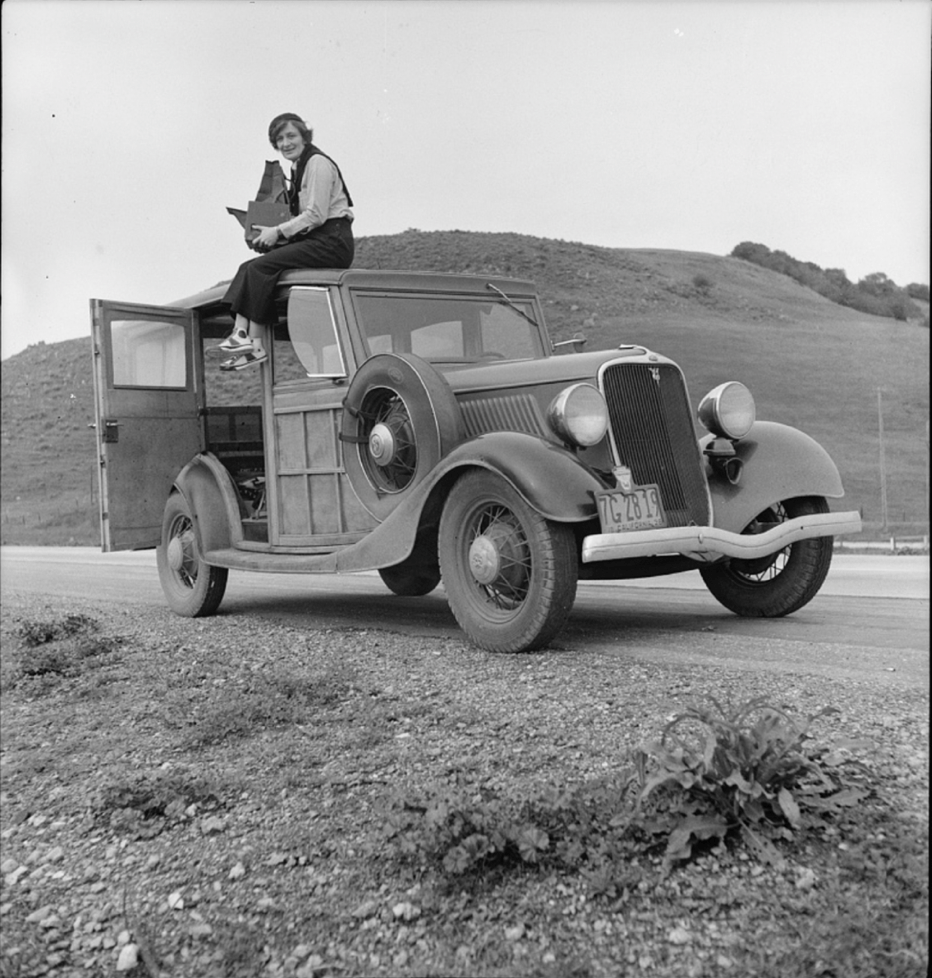
Unknown photographer, Dorothea Lange, Resettlement Administration photographer, in California, 1936, L.O.C.
Just a mile from the White House reception, at the National Gallery, was an exhibition called “Seeing People” consisting of photographs by Dorothea Lange. If the former event was intended as puffery for the powerful, the latter was propaganda for the weak. Lange documented poverty, migrant labor, racism, and internment. Her photography for the U.S. Resettlement Administration, Farm Security Administration and War Relocation Authority from 1935 to 1941 comprises one of the most achieved archives in the history of the medium, rivalling Jacob Riis’s documentation of New York tenements, How the Other Half Lives (1890); Lewis Hine’s photos for the National Child Labor Commission (1908-18); and James Van Der Zee’s pictures of the Harlem Renaissance. Lange was one of 11 photographers – including Walker Evans, Ben Shahn, Russell Lee, Gordon Parks, Arthur Rothstein, and Marion Post Wolcott — commissioned by Roy Stryker (a government economist and amateur photographer), to represent the struggles of the rural working-class during the Great Depression with the goal of increasing public support for New Deal programs. Evans and Shahn were the best artists in the group, but Lange was the best photo-journalist. Her pictures told stories that people could understand.
Plantation Overseer. Mississippi Delta, near Clarksdale, Mississippi
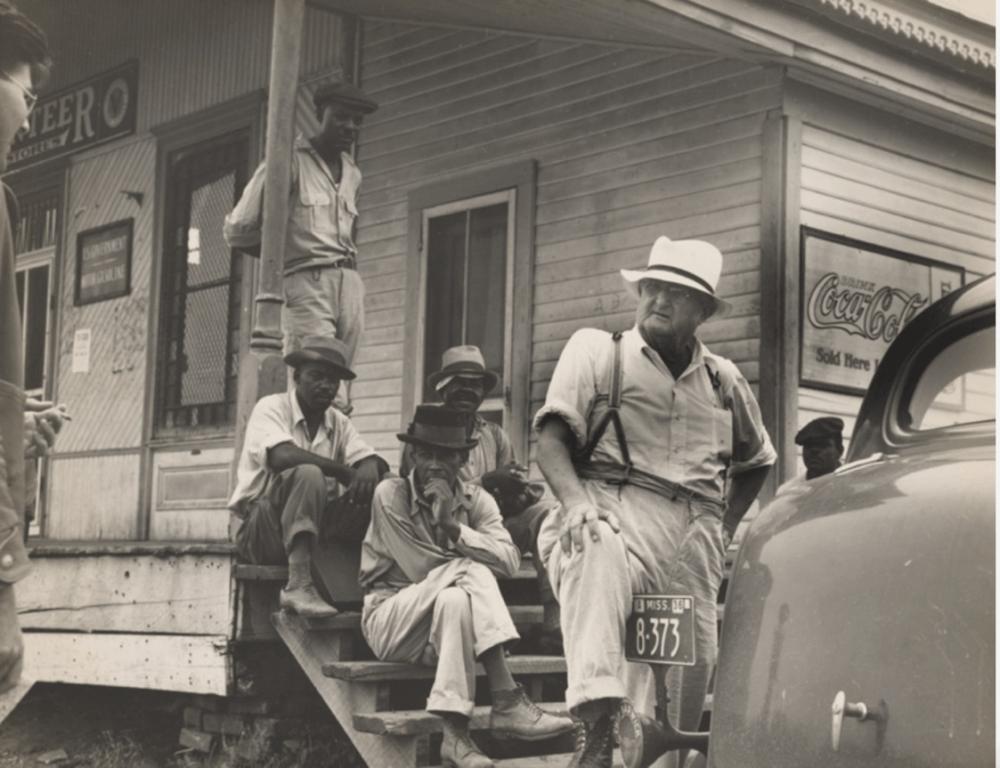
Dorothea Lange, Plantation overseer. Mississippi Delta, near Clarksdale, Mississippi, 1936. Art Institute of Chicago.
Plantation overseer shows a group of men in front of the Volunteer General Store on the Sterlingwell Plantation. A heavy-set, mature white man stands in the foreground with his right foot on the bumper of a shiny new car. On the porch behind him are five Black men, probably local field hands, one of whom is nearly hidden by the vehicle; only his head is visible. At the far left of the picture, cut off by the frame, are the face and hands of a young, white man, the economist Paul S. Taylor, who is also the husband of the photographer. He’s holding a cigarette and talking to the older white man, distracting him so Lange can take a more candid shot.
The overseer’s name is Boon Mosby Partee, described by A.J. Cowart, (a fieldhand on the Hillhouse Plantation), as “the meanest man there ever was.” Born in 1868, Boon was the son of “Squire” Partee, who owned Hillhouse near Clarksdale and 100 slaves. After the Civil War, the Squire lost the farm, but decades later, his son wound up managing it. No information is available about the identities of the Black men. The car is a Chevrolet coupe. Circling the taillight is visible the name “Chip Barwick,” who owned a Chevy dealership in Memphis beginning in 1931. To buy his ride, Boon probably took the Yazoo Delta Railway — aka “Yellow Dog Railroad” — from Clarksdale. The rail line was the subject of Robert Johnson’s Travelling Riverside Blues, recorded in 1937. Black and white in the Mississippi Delta led segregated but overlapping lives.
Interpretations of Lange’s photograph usually focus on the proprietary gesture of the white man with his foot on the bumper; it suggests his proprietorship of the Black men as much as the car. (The Museum of Modern Art titles the work Plantation Owner and his Fieldhands.) And that was likely Lange’s intention too. But unless Partee brought the five men with him in his fancy new car, they probably have nothing to do with him. The store was located on Sterlingwell, not Hillhouse plantation, and Partee probably drove to the Volunteer Store to buy gas or other provisions. Lange’s photograph of the store taken a month later indicates that Black men and women – and white children – were regularly seen on the porch and on the dirt road in front. Lange and Taylor likely thought the man with the white hat and new car would be a good subject, engaged him in conversation, and took the picture. The Black men just happened to be there, or else gathered to see the car and the female photographer.
The fieldhands may have known Partee from his reputation for cruelty, but there’s no evidence they were cowed by him. The area was a hotbed of union organizing by proud tenants (sharecroppers) challenging evictions and reduced pay. Efforts by the Agriculture Adjustment Administration to raise crop prices by paying farm owners to limit production had the unintended consequence of increasing unemployment and depressing wages. In addition, plantation owners and overseers reused to share federal payments with tenants as required by law. Unionized tenant framers challenged the injustice. They met – often surreptitiously — in halls, churches, and private homes across the Delta, supported by white lawyers, and local Communist Party members (white and Black). Some carried guns. Cotton pickers in the Delta even went on strike in 1935 to demand fair distribution of farm subsidies and higher wages. Though the strikers suffered physical attacks – including several murders – they succeeded in obtaining a significant pay raise and partially stemming evictions. An extensive oral history of the STFU, collected in 1974, reveals the courage and resilience of union members. The Civil Rights organizing of the 1950s and ‘60s had its roots in the Mississippi Delta of the 1930s.
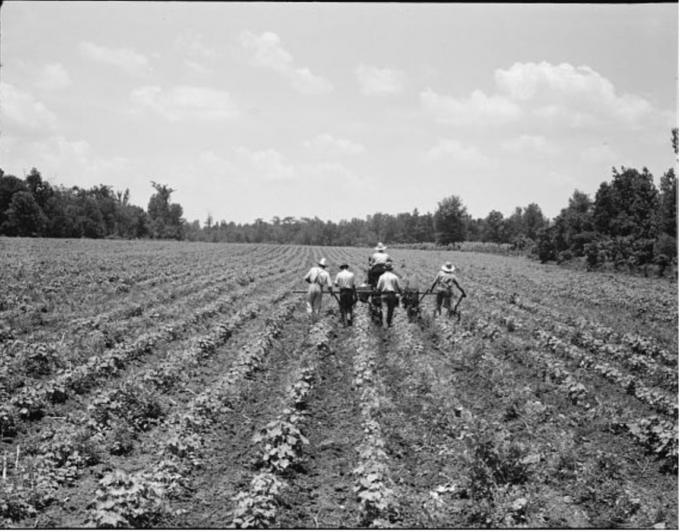
Dorothea Lange, Delta cooperative farm. Hillhouse, Mississippi, June 1937. Library of Congress.
A year after Lange photographed Boon Partee and the Black fieldhands in front of the Volunteer General Store, she returned to the area to photograph the Christian socialist founded (and STFU supported), Delta Cooperative Farm, near the old Hillhouse Plantation. The farm was dedicated to efficiency, cooperation, racial justice, and equal pay for equal work. Lange’s photos of the farm are for the most part unremarkable: Neat crop rows, community gardens, new tractors, well-built cabins, and farmhouses. There’s no evidence of what Mr. Partee thought about his new neighbors, who may have included the very Black men in Plantation Overseer.
Migrant Mother – photography into art
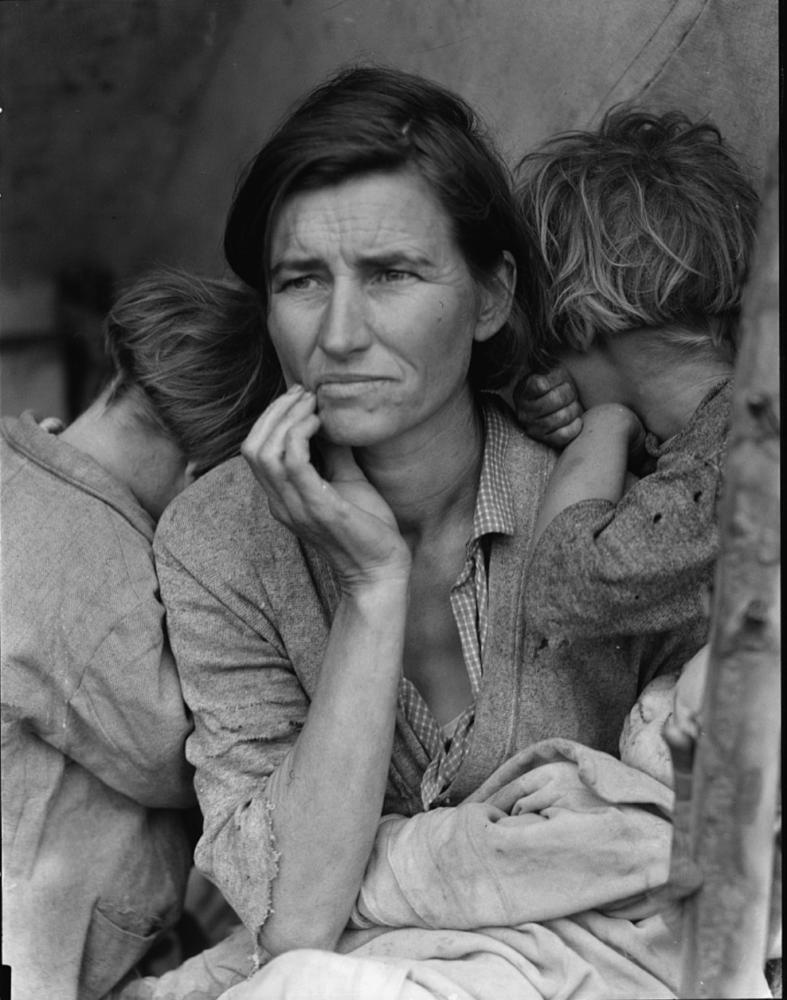
Dorothea Lange, Destitute pea pickers in California. Mother of seven children. Age thirty-two. Nipomo, California, [“Migrant Mother”], March 1936. Library of Congress.
Lange’s best-known photo for the Resettlement Agency and Farm Service Administration — and among the most famous pictures ever taken — is one now called, Migrant Mother, which shows a woman named Florence Owens Thompson with three of her children. Lange much later recounted that the picture came about almost by fate. Driving home to Berkeley after a long assignment in Los Angeles, Lange passed a sign outside Nipomo (south of San Luis Obispo) that read: “Pea Pickers Camp.” She drove 20 miles past it before deciding to turn back. Lange had been there briefly some months earlier and decided she needed more pictures. Arriving at the rain-soaked camp, she got out of her car and looked around. Lange wrote:
“I saw and approached the hungry and desperate mother, as if drawn by a magnet. I do not remember how I explained my presence or my camera to her, but I do remember she asked me no questions…She told me her age, that she was thirty-two. She said that they had been living on frozen vegetables from the surrounding fields, and birds that the children had killed. She had just sold the tires from her car to buy food.
Pea picking was done by migrant workers, their numbers at this time swollen by thousands of families displaced by the Dust Bowl that decimated the Great Plains. Though farm conditions in California were much better due to better irrigation, regular rainfall and seasonally cool weather, the Depression reduced commodity prices and wages there too. Pickers earned barely enough to eat, and not nearly enough to pay for housing. Area residents, often driven by racial bias (many of the pickers were Latino or Asian), resisted the provision of permanent housing. A U.S. government report from 1938 described conditions in the camps:
“[Migrant workers] must either provide their own housing or take up their residences in any abandoned shack that may be handy. In many instances improvised habitations are built of burlap, boxes, brush, packing cases, tin cans, cartons or whatever may be available on the location, and occasionally we find them housed in abandoned stables.”
In 1937, a law was passed by the California legislature forbidding residents from knowingly bringing “any indigent person” into the state. (It was later overturned by the U.S. Supreme Court.) Other exclusionary measures were also taken. In February 1936, a month before Migrant Mother, Los Angeles police initiated a “Bum Blockade” at key points of entry into the state, arresting and deporting anybody deemed indigent. We know from Lange’s letters to Stryker that she was aware of these measures, disturbed by them and aimed to challenge them through her photographs.
Unfortunately, Lange’s memory of the origins of Migrant Mother was partly mistaken. As the photo historian Sally Stein and others have shown, Lange mixed up the story of Owens Thompson with another of her subjects. The woman in Lange’s famous picture was not a pea picker at all. She and her family were in fact on their way back to Oklahoma after her husband lost his lob in a sawmill in Northern California. Their car had broken down, and Thompson’s husband and son had gone off to try and fix it. (They had not sold the tires for food.)
When Lange approached the Thomson family in their tent, was she struck by the resemblance of the scene to a Christian nativity, like the one below by Piero della Francesca?
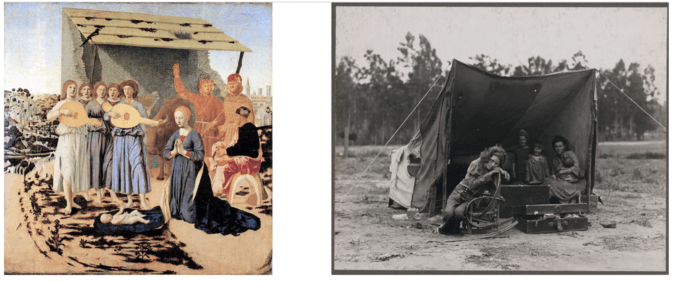
Piero della Francesa, Nativity, National Gallery, London, c.1475; and Dorothea Lange, Migrant agricultural worker’s family. Seven hungry children. Mother aged thirty-two. Father is native Californian. Nipomo, California, March 1936
After taking a few medium shots, Lange turned her Rolleifex camera vertically, and took a pair of close-ups, including Migrant Mother, which recalls another subject in Christian art, the Madonna and child and John the Baptist.
Finally, Migrant Mother also brings to mind work by Julia Margaret Cameron, Lange’s greatest female antecedent. Cameron aimed to “to ennoble Photography and to secure for it the character and uses of High Art by combining the real and the Ideal.” Something similar could be said about Lange’s Migrant Mother. It combined the self-consciously artistic pictorialism of her teacher Clarence White, with the rationalism and facticity of her contemporaries, including Walker Evans. Migrant Mother was Lange’s most ambitious effort to turn documentary photography into art and put it to use to ennoble and empower the poor and vulnerable.
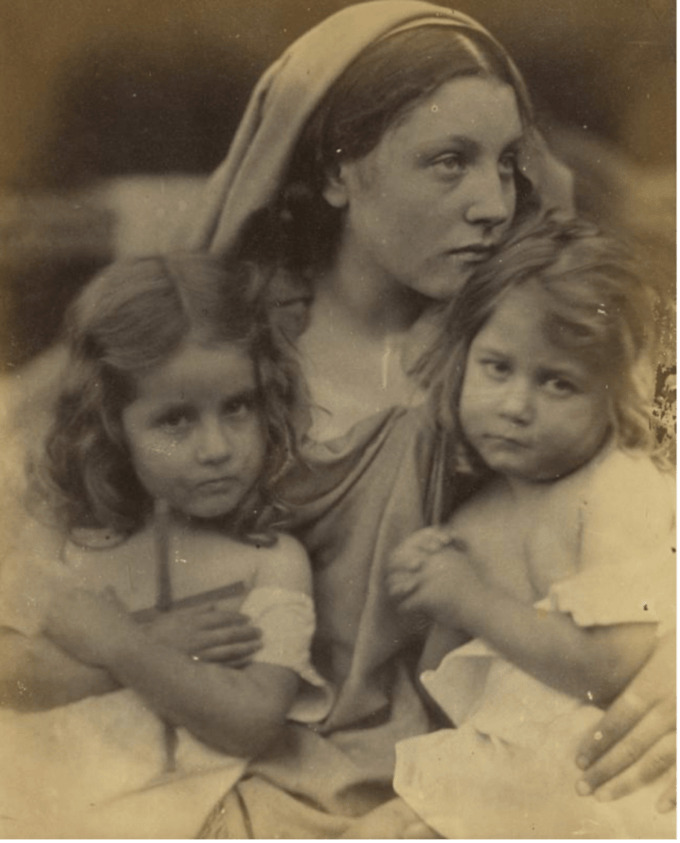
Julia Margaret Cameron, Faith 1864. Scottish National Portrait gallery, (public domain).
Art and politics
Not all art seeks to persuade. Some is simply itself and nothing else, providing a brief and salutary respite from a global capitalist order that seeks at every turn to sell, coerce, persuade, dominate, and sometimes even kill us. Autonomous art, however, is a poor tool in the fight against fascism – which artists in the 1930s and again today must confront. Lange and the rest of the RA/FSA photographers were among the best anti-fascist, artist-warriors of their time. Their photographs reached millions of people. John Steinbeck’s novel Grapes of Wrath (1939) and the film adaptation by John Ford a year later were both deeply influenced by these photographs and reached millions more in the U.S. and around the world.
There is today no equivalent to the New Deal art programs that functioned in the 1930s, which included the Public Works of Art Program (1933-34); the Treasury Section of Painting and Sculpture (1934-43); the Federal Art Project of the Works Progress Administration; and the Resettlement Administration and Farm Security Administration. The failure of the current administration to recognize and respond to the depth and breadth of the crises we face – political, environmental, economic, military – was once again apparent when I saw President Biden in the White House two weeks ago and heard his anodyne remarks. My concern was reinforced when I saw the exhibition of photographs by Lange – engaged, informed, challenging, and ambitious – the following day. The work of the new year must be to keep the orange fascist out of the White House. (Under conditions of fascism, no progress of any kind is possible – there is only regression and death.) But there must a concomitant effort – including by artists — to inform, organize and persuade political leaders and the masses to address the national and planetary crisis.
Stephen F. Eisenman is Professor Emeritus of Art History at Northwestern University and the author of Gauguin’s Skirt (Thames and Hudson, 1997), The Abu Ghraib Effect (Reaktion, 2007), The Cry of Nature: Art and the Making of Animal Rights (Reaktion, 2015) and other books. He is also co-founder of the environmental justice non-profit, Anthropocene Alliance. He and the artist Sue Coe have just published American Fascism, Still for Rotland Press. He can be reached at: s-eisenman@northwestern.edu.
CounterPunch is reader supported! Please help keep us alive.
The CounterPunch website is offered at no charge to the general public over the world wide web. New articles, from an independent left-leaning perspective, are posted every weekday. A batch of several articles, including the Poet’s Basement, and Roaming Charges by Jeffrey St. Clair, are posted in the Weekend Edition. After the initial posting, these articles are available in the archives which can be searched by using any of the search boxes on the website. CounterPunch also publishes books, and published a newsletter and magazine from 1993 to 2020. The CounterPunch+ Subscriber area of our website features subscriber content and access.


Spread the word